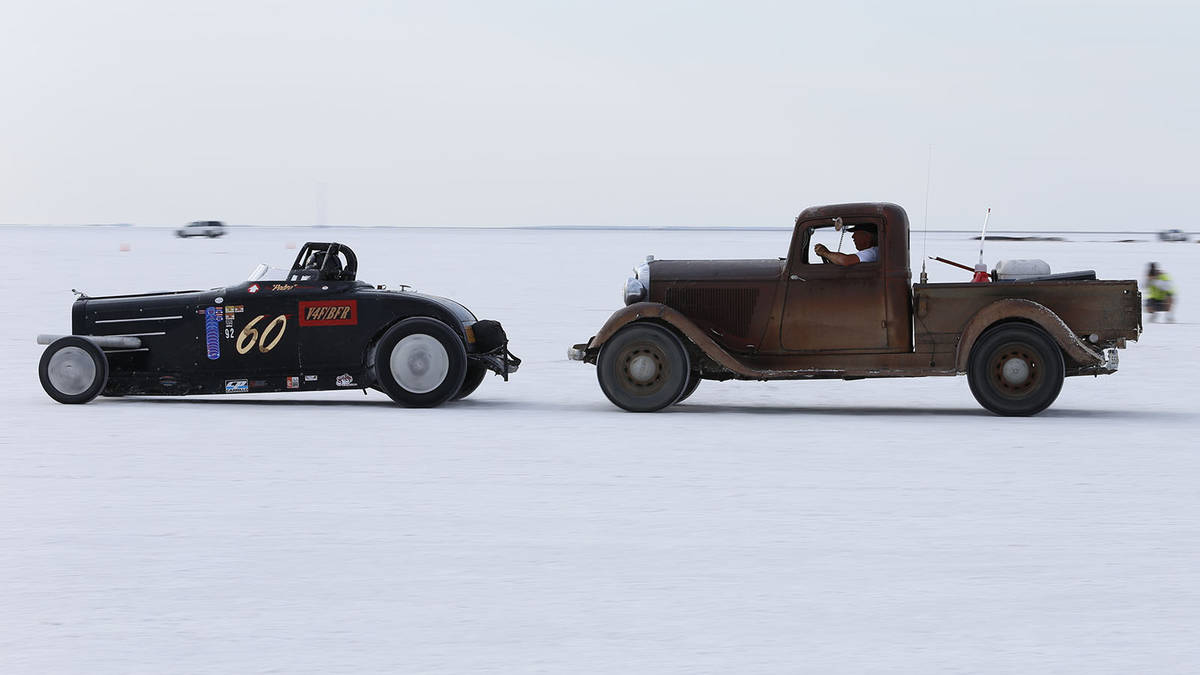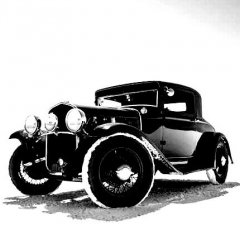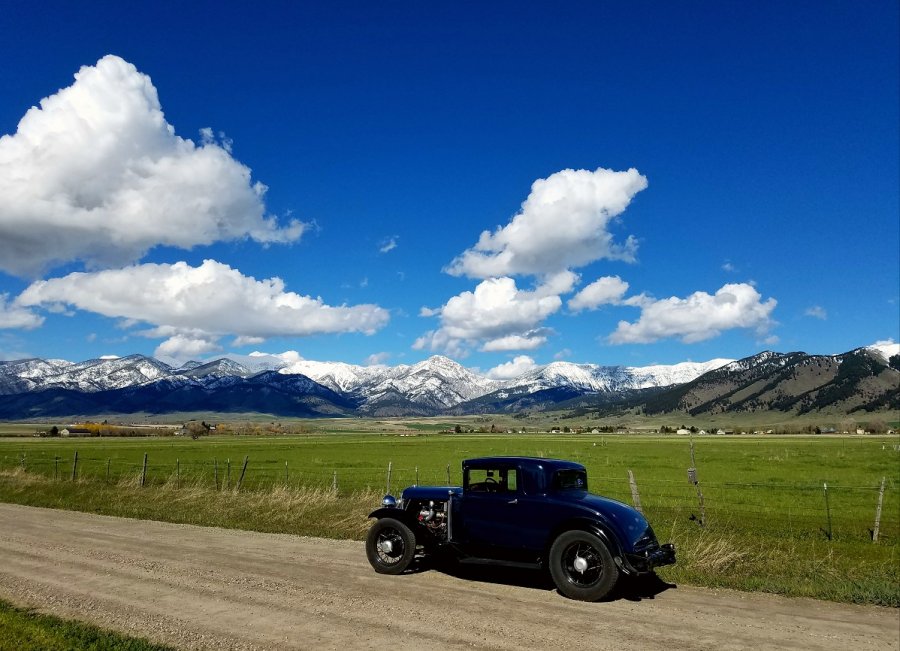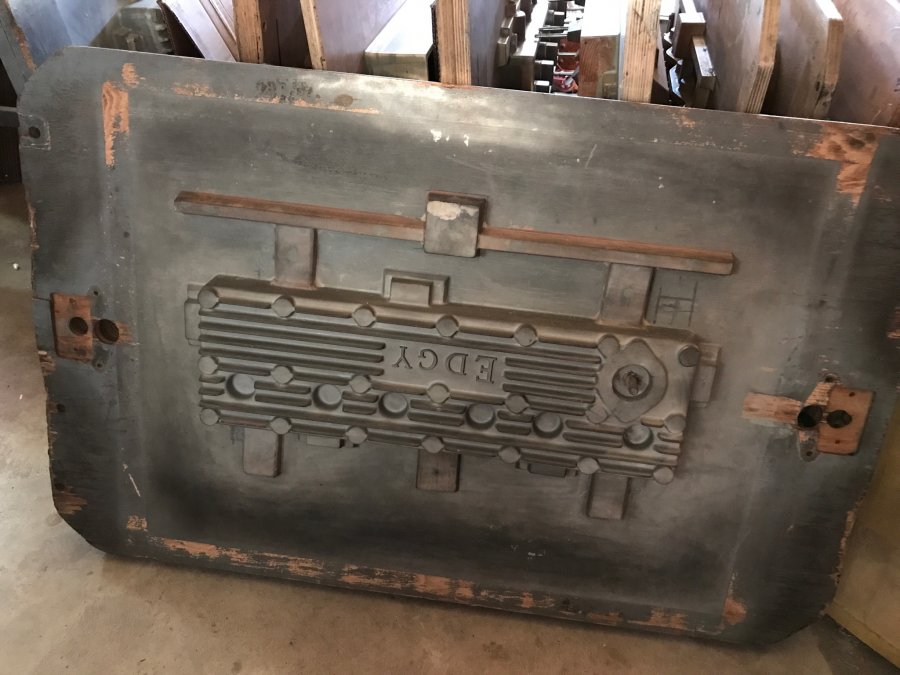-
Posts
151 -
Joined
-
Last visited
-
Days Won
8
Everything posted by MoparMontana
-
IOE SBC intake valves SBC roller rockers I kept the CR on my 230 at 7.5:1 because it is supercharged with a McCulloch VS-57. Earl and Chris run about 9:1. None of the 265 street heads have been fitted yet. The 265 race head is 11.2:1. Oil... drill a passage horizontally through the block under the lifter galley to intersect the middle cam bearing. Die grind a groove in the block to join the 6 o'clock oil feed hole and the 3 o'clock passage you just drilled. Reinstall cam bearing. Drill vertically from the galley floor to intersect the horizontal passage. Install 1/8 NPT pipe plug in external horizontal hole. Install 1/8 NPT to compression fitting in galley hole. Install TIG welded stainless oil manifold in compression fitting. Insert open ends of old manifold tubes into lifter oil holes on block. Secure with epoxy. Oil passes through pushrods to rockers and returns to the galley through cast "pucks" pressed into what were formerly the intake valve seats. Earl and I run 3 Strombergs. Chris runs 3 Webers but I am switching to a stealth EFI set up on my Desoto at some point. Linkage isn't any different than any multi-carb setup.
-
in the mail
-
-
I would do a reground cam and also mill the head, but you can't determine how much to mill it until you know the new cam specs. 25" high-compression aluminum heads will be available mid-summer. Advertised duration on a stock cam was 236*. I'd go with a 260* (222* @.050) .410" lift.
-
I would guess a F-head alone easily bumps the HP by 50%. I'm only running 2# of boost, so maybe 10% more than that.. so maybe 165-180 HP? It's not a tire smoker, but it has no issue accelerating and keeping up with modern traffic. Bot Chris' '35 pickup and my DeSoto easily cruise Montana roads at 75 MPH, and get almost 20 MPG. Neither is really a performance build though. Mine is on a bone-stock short block. We are working on two 265 F-heads now, one for Chris' '33 DeSoto and the other for my '33 Chrysler convertible. These will be full-on hot rod builds with custom Carrillo rods, lightweight forged CP pistons, ARP studs, etc. I'm even considering a stealth EFI set up on mine. As far as the hemi head, one of the reasons Earl stepped back from selling heads was so he can focus on an true OHV head for his Bonneville race car.
-
Just wait....
-
Andy, Earl hates the business side of it. He has been a friend since Chris and I first started crewing for him at Bonneville in 2004, and he started sponsoring the Fast Four Special when we started running in 2008. Every time he threatened to quit making heads, which he did a lot, I suggested that he let me do the production, sales and marketing stuff so he could free up time to continue to make patterns. I like the stuff he hates, but I am not smart enough to do what he does. When his local foundry closed this year, called me and said "lets do it". He still owns the patterns, but I am producing and marketing the heads, intakes, cams, etc (as well as forged pistons, studs, etc) and paying him a royalty for each EDGY product sold. It's better for everyone. We can both stick to what we're good at, and he will have more time to make patterns. You should see the HEMI head! More importantly, everything will be on the shelf, ready to ship as soon as we're 100% up and running.
-
That's very interesting. Thanks for letting me know. I had never heard that rumor about cooling issues, not have I or any of my buddies that run them experienced a problem. I will ask Earl about it though. I did run a head on my Chrysler for a few years before I put the 265 in that was returned to Earl because the owner claimed it had porosity and wept coolant. I ran ceramic Irontite through it and ran it for 5 or 6 years without any issues. I know for a fact that one of the biggest issues with EDGY heads over the years was the consistency of the castings coming out of the foundry he was using. He had a lot of core shift and porosity problems, and for one reason or another they weren't working together to find the root cause. I know one of the foundries he was using he had about about a 20% reject rate. I do suppose if you had a head that had significant core shift and/or porosity it would lead to hot spots and overheating. The reason I chose EDELBROCK to do the new castings, even though they are more expensive, is their communication and willingness to improve upon the product. the patterns will be scanned, 3D modeled, and improved upon to meet modern specifications. As far as performance improvements, we have taken what we have learned on the flowbench with our Bonneville flatheads and made some subtle improvements in the chamber design. The chambers will also be CNC machined. The Gen I EDGY heads had as-cast chambers and we have found variances as large as 3cc per chamber on one head. Finally, the entire head will be CNC machined. Earl machined each head on the old Bridgeport in his garage. Edelbrock is manufacturing the Gen II heads A-Z; pattern improvements, better casting quality and consistency, better QC, and CNC machining, including the combustion chambers. All that being said, I'm confident that any rumors floating around, true or not, will be non-issues when the first batch of Gen IIs is done in June. PS- if anyone has any first-hand knowledge of problems with the old EDGY heads, please let me know. If you return a damaged Gen I EDGY head to me that had a manufacturing defect, I will sell you one of my Gen IIs to you for my cost.
-
-
-
Muddy afternoon at the Ranch, but the chassis and engine are headed to the shop. It's going to be a busy weekend!
-
Here is a link to the Facebook page that the owner of the car created. https://www.facebook.com/PekingtoParis2019/ Cheers, Pete
-
I get the impression this will be vintage race car until the end. I suppose that is part of the reason the owner and I found each other. I turned a 1928 Dodge roadster into a Bonneville racecar, my '33 Chrysler convertible (one of 577 built) has a warmed-over 265 and overdrive, and my '31 Desoto (one of 1200+/-) has a supercharged 230 with an F-head. (#31FheadDesoto). I am a racer/hotrodder at heart, I sell L-head speed parts as a hobby, and I feel properly done, tasteful, period-correct performance modifications add value both monetarily and in terms of enjoyment... not to mention that you can drive them thousands of miles, dependably, at highway speeds.
-
We dug through the engine pile on the Ranch and found a beautiful standard bore 230. We will be disassemble, tank, inspect and magnaflux this weekend.
-
The rationale for the T5 The owner wants the car switched to LHD and he wants to use a stock pedal assembly so it appears stock from above. The inboard side of the pedal assembly is mounted to the bellhousing and is visual from the engine compartment. Ford T5s have the correct length 1" 10 spline input shaft so a stock flywheel, pressure plate, and clutch disc, and mechanical linkage can be used with a pilot bushing adapted Aftermarket Temec versions of this tranny have multiple gear ratios available and multiple shifter locations. I am not personally opposed to other alternatives, but this seems like the best choice given the parameters. I have a Mazda B2000 tranny in my '26 dodge speedster.
-
Very similar with some very small changes. Learning more every day. We were surprised to find this weekend when looking at several chassis back to back that the frame rails of the longer wheelbase trucks were made from heavier gauge steel than the 1/2 tons.
-
Interesting. I'll be doing some Goolging tonight... not that it really matters.
-
No rubbing. Just trying to clarify. My '33 is mostly original, including the paint. When I bought it, it had a tired 40's 218. I drove it for several year until the 218 gave up. I put a fresh, high compression hopped up '54 265" L-6 and overdrive in it last winter, but other than that it is still stock.
-
Yes, the actual car. It's an older photo. The gentleman who bought it stripped it to prep for the rally. We are actually receiving it disassembled.
-
TJ Richards was a body builder in Australia. They built 1933 Dodge roadsters on 1933 Dodge 111" commercial (aka 1/2 ton pickup) chassis.





















